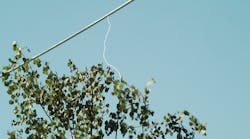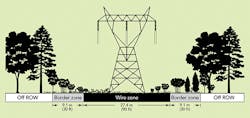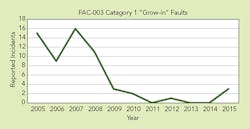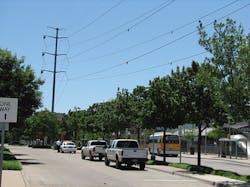Following the Northeast blackout of Aug. 14, 2003, the Federal Energy Regulatory Commission and, subsequently, the North American Electric Reliability Corporation (NERC) have been focused on reducing vegetation-related incidents by enforcing a transmission vegetation management standard. This standard, FAC-003-1, was adopted in 2006 and enforced in 2007 as a NERC facilities design, connections and maintenance reliability standard for the electric utility industry.
A review of the record of reportable Category 1 grow-in outages since 2005 demonstrates the industry has been successful in reducing the instances of flashovers occurring because of vegetation. Testing completed by the Electric Power Research Institute (EPRI) on the strength of the air gap between transmission conductors and trees established an empirical basis for developing new minimum vegetation clearance distances (MVCD), now included in FAC-003-4.
The testing also provided new insight into how the shape of trees growing in proximity to energized conductors influences the likelihood of a flashover. The weakest air gaps were associated with large, flat tops growing directly below energized high-voltage conductors. This crown form can take shape when trees growing beneath the transmission conductors are repeatedly maintained by height-reduction pruning.
Integrated Vegetation Management
The U.S. has more than 160,000 miles (257,495 km) of transmission line operating in the range of 230 kV to 765 kV. The total land area being managed as transmission corridors has been estimated at between 9 million acres and 11 million acres (3.6 million hectares and 4.5 million hectares). This land area is typically managed using the principles of integrated vegetation management (IVM), which are intended to create, promote and conserve stable plant communities compatible with overhead transmission lines, and to discourage incompatible plants that may pose a risk to the reliable operation of the transmission system.
The American National Standards Institute and industry best management practices define IVM on transmission rights-of-way (ROW). IVM uses combinations of methods to promote sustainable plant communities compatible with the intended use of the site and to control, discourage or prevent the establishment of incompatible plants that may pose safety, security, access, fire hazard, utility service reliability, emergency restoration, visibility, line-of-sight, regulatory compliance, environmental or other specific concerns.
Both references define a wire zone below the electric supply lines, which is typically managed to promote low-growing, primarily herbaceous, vegetation.
Incompatible tree species growing in the wire zone present the greatest likelihood of encroachment within MVCDs, leading to a reportable Category 1 event.
Air Gap Factors and MVCD
MVCDs in the initial version of FAC-003-1were based on IEEE standards that established minimum air insulation distances (MAID) for live-line work. The MAID and MVCD distances were determined for the case when a transient overvoltage (TOV) occurs because of a switching operation. The MAID clearance distances, which pertain to line work, were believed to be very conservative when applied to tree-conductor clearances.
The calculation method for determining MVCDs in later versions of FAC-003 uses the Gallet equation multiplied by a gap factor to describe the strength of the air gap. MVCDs in subsequent versions FAC-003-2 and FAC-003-3 are based on this method and also used a level of expected TOVs by voltage class. MVCDs in both the second and third versions of the standard are based on a gap factor of 1.3.
As a result, new MVCDs were approved with an additional caveat directing NERC “to conduct or contract testing to develop empirical data regarding the flashover distances between conductors and vegetation,” and to use an approach based on “statistical analysis [that] would then evaluate the test results and provide empirical evidence to support an appropriate gap factor to be applied in calculating minimum clearance distances using the Gallet equation.”
Out of 20 high-voltage tests performed by EPRI, 12 yielded gap factors lower than 1.3, which was used in the calculations to determine the MVCDs in FAC-003-3. These test results indicated a gap factor of 1.3 may not be suitable for all situations. As a result, the NERC advisory team recommend a gap factor of 1.0 as a more conservative approach.
FAC-003-4 reflects the revised MVCD values using the Gallet equation and a gap factor of 1.0. MVCDs in FAC-003-4 were increased compared to FAC-003-3 based on the lower gap factor, yet they are still less than those found in FAC-003-1.
Air Gap Flashover Testing
The testing focused on MVCDs, which, by definition, apply to distances between trees and conductors, and are relevant to two categories of reportable outages, as defined in FAC-003-3:
• Category 1 grow-in outages are sustained outages caused by vegetation growing into applicable lines by vegetation inside and/or outside the ROW. They relate to a vertical gap.
• Category 4 blowing together outages are sustained outages caused by vegetation and applicable lines blowing together from within the ROW. They relate to a horizontal gap.
Outages as a result of tees failing structurally and striking transmission conductors (Categories 2 and 3) were not included in the investigation.
The history of reportable incidents since 2005 was reviewed to determine the species and crown characteristics of trees involved in reported outages. This information was used to determine the tree types tested.
Switching surge impulse tests were performed for each system voltage level to determine the average strength (critical flashover voltage) of the conductor to tree gaps. The results were then used to determine whether the gap factor used with the Gallet equation to calculate the MVCDs was appropriate. These tests revealed a gap factor of 1.0 was more appropriate to use than a gap factor of 1.3.
Revised MVCD values in FAC-003-4 were calculated based on a gap factor of 1.0 and tests performed again at the TOV levels specified in the standard to show the conductor tree gaps were able to withstand the voltages. The switching impulse flashover and withstand voltages are significantly greater than the nominal line AC voltages, because MVCDs are determined by applying switching overvoltages and not everyday 60-Hz operating voltages.
One of the key findings from the test was the impact of the tree size and shape on the flashover strength of the air gap between the tree and conductor. This impact can be explained theoretically:
•The weakest conductor gap is a conductor-plane gap, which had a gap factor of 1.1. This is similar to a conductor vase-shaped tree gap, which was measured with a gap factor between 1.03 and 1.15.
• The strongest conductor gap is considered to be a conductor-rod gap, which had a gap factor between 1.4 and 1.6. This is similar to a conductor pyramidal-shaped tree gap, which was measured with a gap factor of 1.44.
As a result, the testing led to a new insight that trees with large flat tops growing directly below energized high-voltage conductors resulted in the weakest air gap compared to pyramidal-shaped trees.
The electric field gradient above flat ground is a uniform gradient. When an object such as a tree is encountered, the field is distorted, bending around it. A tree crown is composed of leaves, wood and water, with the majority of the volume often simply air space. While not a solid object, it has sufficient electrical permittivity to influence the shape of the electric field distribution. Thus, a broad flat-topped tree crown distorts the electric field in a manner similar to a plane, resembling a conductor-plane air gap.
Factors in Conductor-Tree Flashovers
The following factors increase the likelihood of a conductor-tree flashover:
•Season. The majority of Category 1 outages reported since 2005 have occurred during the growing season because of the following reasons:
- Tree growth varies within a growing season. Stem elongation begins shortly after full leaf development and is typically completed by August. As a result, clearance is lost during the first half of the growing season.
- Ambient air temperatures and system loads are high in the summer, resulting in greater conductor sag and loss of clearance.
- The crown of a deciduous tree more closely simulates a conductive plane during the growing season because of the presence of more leaves and increased moisture in the branches.
•Voltage. The 230-kV MVCDs (based on a gap factor of 1.3) found in FAC-003-3, when tested from conductor to a broad flat-topped tree, failed the voltage withstand test and are the primary reason the MVCDs in FAC-003-4 are being revised to use a more conservative gap factor of 1.0. Therefore, through testing, the revised MVCDs were evaluated for various tree shapes, below or adjacent to lines of any voltage class.
• Line clearance pruning. While some species of trees may naturally develop broad flat-topped crowns, this condition is more likely to be created by trees maintained by crown-reduction pruning using directional pruning techniques, which involve selective removal of limbs to reduce the overall height of a tree. The result of pruning can lead to the development of a broadly spreading flat-topped crown directly under transmission conductors.
As identified in the EPRI testing, this is the type of tree-conductor configuration that results in the weakest air gap. Directional side pruning of trees along the edge of narrow corridors also has the potential to create a horizontal plane with a similarly weakened air gap.
• Riparian zones. It is not uncommon for there to be a requirement that trees be retained in areas adjacent to streams and wetlands. In some cases, it may be necessary to top trees in these areas. These sites have the potential to create elevated risk due to the development of a flat-topped crown form. They also typically have deep fertile soils and adequate moisture for optimal tree growth rates, and often occur at mid-span, where conductor sag can be significant.
• Visual screens. Vegetation has been used to maintain a visual screen or barrier between areas frequented by the public and a transmission line ROW, or undesirable land uses beyond. Visual screens may be mandated specifically as part of the regulatory process and requirements for siting as well as ROW clearing for new facilities. This requirement often extends beyond initial clearing and carries forward to future maintenance operations.
The retention of trees with mature height growth potential well above that of conductors in visual screens and barriers may be well intended, but it creates unintended risks of a Category 1 air gap flashover outage.
• Landscape tree restrictions. Tall-growing trees can still be found in the wire zone directly under high-voltage transmission lines because of restrictions placed on utility vegetation maintenance activities by private and public tree owners. The public may have an affinity for trees but limited or no understanding of the risk they pose to the reliability of the power grid.
Repeated pruning of landscape trees directly under transmission conductors on sites such as lawns, along streets and in parks also has the potential to expose the public to high current ground faults, which may cause serious injury, up to and including death.
Each of these factors may increase the risk of an encroachment within the MVCDs, and they must be managed appropriately to ensure reliability of the transmission system.
Likelihood of Air Gap Flashovers
The revisions to the flashover voltages in MVCDs in FAC-003-4 provide a substantial degree of certainty that, with compliance, the likelihood of a flashover between an energized conductor and a tree is extremely low. The MVCDs are based on potential transient overvoltage (switching surge) conditions associated with switching operations in the system. The vast majority of the time, the system operates at steady-state nominal voltages.
The industry recognizes MVCDs are not the targeted clearances for a vegetation management program and has a goal to maintain tree-conductor clearances well in excess of MVCD.
The weakest air gap tree-conductor configuration identified in the study was that of a broadly spreading flat-topped tree directly below a conductor, which yielded a gap factor between 1.03 and 1.15. Since these gap factors are higher than the 1.0 gap factor used for the MVCD calculations, the actual likelihood of a flashover was reduced because the actual MVCDs require greater clearance.
Testing provided a new insight regarding the influence of tree shape on the likelihood of an air gap flashover. This new information will provide practitioners with an informed basis to enhance vegetation maintenance strategies and methods for trees being maintained on transmission ROW.
A Better Understanding
EPRI’s testing on the strength of the air gap between energized high-voltage conductors and trees established a quantitative basis for the MVCD values in FAC-003-4. Maintaining the new flashover MVCDs reduces the likelihood of an air gap flashover to a tree on the transmission system.
The tests also demonstrated that trees with broad flat tops growing directly below high-voltage conductors create the weakest air gap for a potential flashover incident. This condition is most often associated with trees being maintained by repeated crown-reduction pruning.
As a result, line clearance pruning of trees directly under transmission conductors may unintentionally increase potential exposure to a flashover between a transmission line and the tree, and emphasizes the need to maintain MVCD within FAC-003-4. A similar condition may develop in the case of trees adjacent to conductors.
Acknowledgement
This article draws extensively from work by both the NERC FAC-003-4 standard drafting team and EPRI project team that conducted the investigation into air gap flashover distances to trees. The intent of this article is to summarize the work products of both teams, which are available in the public domain.
John Goodfellow is a principal consultant for BioCompliance Consulting Inc. and a vegetation management researcher with more than 38 years of experience in the electric utility industry. He has held positions in vegetation management, T&D operations, maintenance, engineering and construction at three electric and gas utilities. He was a member of the EPRI project team that completed the empirical study of air gap flashover between transmission conductors and trees, and provided direct support to the North American Electric Reliability FAC-003-4 standards drafting team in assessing the implications of the new minimum vegetation clearance distances to contemporary vegetation management programs.











